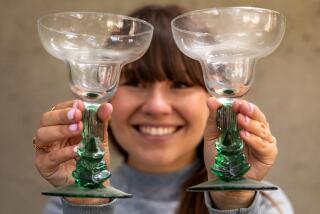A Visit to These London Auctions Gets You Something for Nodding
- Share via
“Oh, I never visit the antique dealers when I’m in London,” laughs a New York City collector. “I go directly to their sources and save piles of money.”
“You mean Sotheby’s in Bond Street and Christie’s in St. James’s?” I ask her.
“Better than that. At the auction houses I go to, I’ve picked up marvelous jewelry and silver for as little as 100 (about $160 U.S.), and gotten some magnificent pieces for less than 500 (about $580 U.S.).”
She showed me a gold and carnelian scarab Etruscan Revival bar brooch, inspired by Victorian archeologists’ finds in the Near East and probably crafted in the 1890s. The gold wirework that experts call cannetille is so fine that it looks as if it had been made and applied under a microscope.
I think of the antique jewelry galleries on upper Madison Avenue and guess “$1,500? $2,000?”
She laughed again. “Only about $400, including the buyer’s $10 premium.” And in rapid succession she handed me several pieces of antique jewelry and silver, crowing over her wonderful finds.
Happily, London’s little-known auction houses are quite accessible. Of the three I like best, two are less than a 15-minute walk from Harrods and one is at the top of New Bond Street, just south of Oxford Street and the tube station. And all of them hold several auctions every week.
Bonhams (Montpelier Street, London SW7 1HH, phone 011-44-1-584-9161), the smallest of the three auction houses, ranks high with foreign visitors because it accepts credit cards. This policy facilitates purchases because buyers don’t have to rush to establish credit, or draw on their banks or on American Express for funds.
In addition, buyers won’t miss out on a precious objet d’art because they are 50 or 100 short of the auction price. And collectors who have credit cards linked to an airline’s frequent-flyer program can rack up mileage for their next trip with every purchase they make.
Bonhams is across Brompton Road from the western entrance of Harrods.
Within its Georgian townhouse, collectors can view the lots to be auctioned as late as an hour before the sale, enjoy a snack at the wine bar and coffee shop on the first floor, facilities unusual in London auction galleries, and then bid at the sale with renewed vigor.
There are many good buys at Bonhams’ jewelry sales, usually held on the last Friday of every month, especially when compared to New York City prices--in Georgian, Victorian, and Edwardian jewelry.
The reason is simple. In Britain the supply of antique jewelry from those eras is still fairly large. For example, at a recent auction collectors found these buys: a graduated bar brooch with small cushion-shaped diamonds for 190, Cartier gold triple-hoop earrings for 270 and a Victorian turquoise and gold bracelet and matching pendant made around 1865, for 500.
Bonhams is perhaps best known for having originated theme sales. Its “Cats in Art” auction is slated for December, and will be followed by “Dogs in Art, Silver, and Jewelry” next February, timed to coincide with Britain’s premier Crufts Dog Show.
Bonhams is also the only London auction house to hold an annual sale of erotica, some of which is extraordinarily fine art. The auction gallery also holds frequent sales of silver, objets de vertu, china, paintings, and English and continental furniture.
Compared to Bonhams, Christie’s South Kensington (85 Old Brompton Road, London SW7 3LD, phone 011-44-1-581-7611), about 10 blocks farther west, is a busy place.
This junior branch of Christie’s in a former aircraft factory holds 10 to 12 auctions, about 3,000 lots, every week.
Christie’s “South Ken” specialties sound like those of Gilbert & Sullivan’s Modern Major-General: arms and armor, art nouveau, cameras and photography, costumes and textiles, dolls and toys, pop memorabilia, models and maritime artifacts, maps, scientific and medical instruments, sporting memorabilia, tools and crafts, transportation art and memorabilia and wine.
Chances are that if people collect it, Christie’s South Ken will have a specialist on hand to evaluate it and will sell it at auction.
Avid collectors can find many bargains there. At a recent jewelry auction a late Victorian 18K gold, ruby and diamond five-stone half-hoop ring sold for 200.
A rose diamond (an earlier form of cut than the brilliant cut) bow brooch with an emerald drop sold for 180. A diamond and square-cut emerald circle brooch sold for 380 and a diamond Scottish terrier brooch sold for 170.
Christie’s South Ken does not accept credit cards, but will take personal checks with identification if potential buyers have registered with Christie’s accounts department upon their arrival in London.
Phillips (101 New Bond St., London W1Y OAS, phone 011-44-1-629-6602) holds a dozen auctions a week. Its Glendinings subsidiary specializes in frequent auctions of coins and medals.
Other Phillips specialties are autograph letters and historic documents, books, atlases and maps, textiles, period costume and couture, stock and bond certificates and banknotes, paintings and drawings of all periods, antique and modern jewelry, silver, ethnographic art and antiquities, lead soldiers and sporting items.
Phillips holds general sales of decorative and fine arts on Monday, Tuesday, Wednesday and Friday at 11 a.m, with viewing on the preceding two days and the morning of the sale.
On Mondays, antique furniture, rugs, ceramics and glass are sold. Antique English and continental furniture, Eastern carpets and rugs, bronzes, and works of art are sold on Tuesdays.
English and continental porcelain, pottery and glass alternate with Oriental ceramics and works of art on Wednesdays, and antique and modern silver are sold on Fridays.
In addition, specialized sales--e.g., Art Nouveau or clocks and watches--are held at least once every quarter and often several times a month.
Again focusing on small, portable antiques, Phillips has much to delight collectors. At a recent silver auction, several Georgian pieces sold at low prices.
A George III swing-handled sugar basket made by William Abdy II in 1792 sold for 300. A George III pierced swing-handled sugar basket with cranberry glass liner made by Edward Aldridge in 1771 sold for 500.
And a George III baluster-shaped sugar dredger with embossed foliate decoration, made by John Delmester in 1761, sold for 380.
Lots of Tips for Bidders
Avoid lots marked with a dagger or asterisk in the auction catalog. They are modern pieces, and buyers must pay VAT of 15% on the hammer price as well as on the 10% buyer’s premium.
If the hammer price is 500 and the object is considered modern, you will have to pay VAT on 550 or a tax of 82.50.
If the object is considered antique and therefore exempt from VAT, you will pay VAT only on the buyer’s premium, or a tax of 7.50. That’s a big difference.
Look for lots that fail to meet their reserve and are “bought in” by the auction house. These lots are usually announced when they fail to sell.
Absent bidders can call the auction house after the sale to ask which lots did not sell. Very often these lots can be bought after the sale for 70% to 80% of their low estimate.
Check with the export department of the auction house to determine if you will need an export license for any of your purchases, so that you can expedite taking or shipping them home.
More to Read
Sign up for The Wild
We’ll help you find the best places to hike, bike and run, as well as the perfect silent spots for meditation and yoga.
You may occasionally receive promotional content from the Los Angeles Times.






